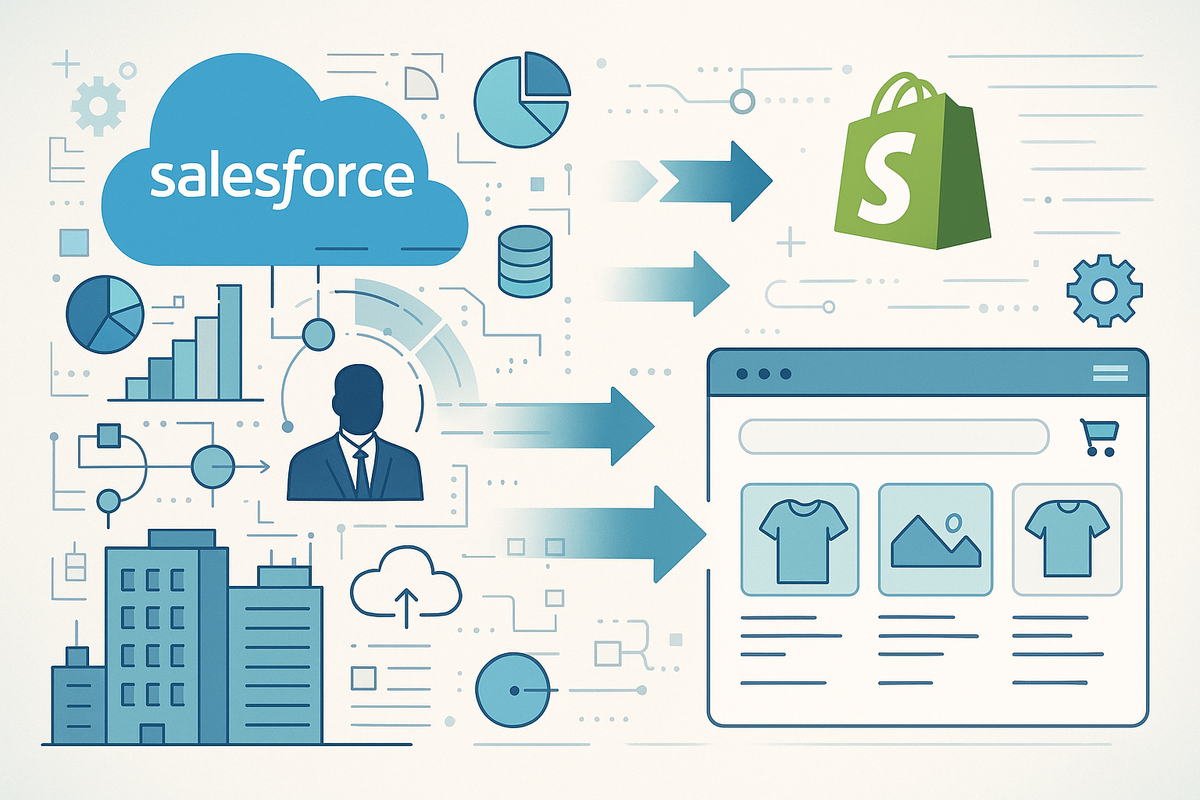As eCommerce demands evolve, the platform powering your store plays a pivotal role in scalability, efficiency, and customer satisfaction. If you're running on Salesforce Commerce Cloud and considering Shopify's agile ecosystem—with its standout features like Shop Pay and unthrottled APIs—the transition could open doors to faster innovation and lower costs. However, a migration of this scale requires careful navigation to avoid pitfalls like data inconsistencies or operational hiccups. Drawing from hands-on experience with hundreds of such shifts at Arctic Grey, this guide delves into the essentials of a smooth Salesforce to Shopify migration. Whether you're aiming to cut expenses or enhance performance, these insights can help you envision a more streamlined future for your online business.
Understanding the Salesforce to Shopify Migration
Migrating from Salesforce to Shopify entails a comprehensive transfer of your store's core components—products, customer data, orders, SEO elements, and more—to Shopify or Shopify Plus. Beyond mere data movement, it's an opportunity to harness Shopify's strengths, such as its 99.99% uptime and native tools for D2C, B2B, Wholesale, and POS operations. For merchants accustomed to Salesforce's robust but often rigid structure, this shift means embracing a platform that prioritizes ease of customization and rapid feature deployment, all while maintaining compliance with standards like GDPR and PCI DSS. The key is ensuring the process preserves your historical data and SEO value, setting the stage for immediate improvements in speed and sales.
The Advantages of Making the Switch
Data from industry benchmarks highlights why many brands opt for this migration, often seeing quick wins in key areas. Here's a comparative overview based on real metrics and case studies:
|
Benefit
|
Shopify Edge Over Salesforce
|
Potential Impact
|
|---|---|---|
|
Conversion Optimization
|
36% higher checkout conversions; Shop Pay boosts up to 50%
|
Drives more revenue from traffic, with over 150 million users favoring one-click payments
|
|
Cost Savings
|
14% lower licensing fees; TCO reduced by 31% on average
|
Frees up budget for marketing or R&D, with implementations often 3x faster and $300K cheaper
|
|
Innovation Speed
|
200+ new features annually; extensible checkout and pre-built integrations
|
Enables quick adaptations like digital wallets or backend extensions without heavy dev work
|
|
Performance & Reliability
|
1.4x faster site speeds; 99.99% uptime with unthrottled APIs
|
Lowers bounce rates and supports seamless scaling for high-volume operations
|
|
App & Ecosystem Flexibility
|
~10,000 apps vs. Salesforce's more limited options
|
Simplifies integrations, reducing dependency on custom coding and enhancing omnichannel selling
|
These edges aren't theoretical—they stem from Shopify's $1.7B annual R&D investment, making it a go-to for brands seeking agility in a competitive market.
Step-by-Step: How a Seamless Migration Unfolds
A structured migration minimizes disruptions and maximizes value. From our observations, the process typically breaks down like this:
- Discovery & Planning: Assess your Salesforce setup, identifying data mappings and custom needs to create a tailored roadmap.
- Data Transfer: Securely migrate products, orders, customers, and SEO elements with zero loss, ensuring historical integrity.
- Design & Customization: Rebuild your store's UX to leverage Shopify's themes, incorporating features like personalized checkouts or cart drawers.
- Testing & QA: Conduct thorough checks for functionality, speed, and compliance, using A/B testing to optimize early.
- Launch & Support: Roll out with minimal downtime, followed by monitoring to fine-tune performance and address any emerging needs.
This methodical flow, when executed well, can complete in 4-6 months, turning potential challenges into growth catalysts.
Real-World Insights from Successful Migrations
The true measure of a migration's success lies in the outcomes for actual businesses. Take one eCommerce director who saw a 250% conversion spike post-switch, crediting enhanced UX and reliable backend support. Another brand experienced a 22% sales uplift in just 30 days, thanks to a partnership that refined every detail over years. Stories from diverse sectors—like fashion and accessories—reveal common threads: faster launches (e.g., under 6 months vs. Salesforce's longer timelines), revenue boosts (up to 22%), and site speed gains (48% in one case). These examples underscore how a well-planned migration not only resolves limitations but also uncovers untapped potential, fostering long-term partnerships built on trust and results.
Why Expertise Matters in Your Migration Journey
In a process as intricate as this, partnering with seasoned experts can bridge gaps in knowledge and execution. Seek out teams with proven track records in Shopify Plus, accolades for design and development, and a focus on 100% client satisfaction. At Arctic Grey, our award-winning methodology—honored for top web development and best agency status—emphasizes secure, zero-loss transfers and ongoing support, drawing from over 300 migrations. It's about crafting a migration that aligns with your vision, ensuring your store emerges stronger and more adaptable.
Looking Ahead: The Role of AI in Future-Proofing Your Store
With AI reshaping eCommerce through smarter data handling and personalization, incorporating these during migration can yield predictive insights and automated optimizations. This forward-thinking integration keeps your Shopify setup resilient against emerging trends like hyper-personalized experiences.
If this overview sparks ideas for your own transition, diving deeper into tailored strategies could be worthwhile. For more on migrating from Salesforce to Shopify, check out our dedicated resource. And if you'd like to explore how this might apply to your brand, the Arctic Grey team is always open for a conversation—let's discuss possibilities.
About Arctic Grey: Specialists in Shopify builds, customizations, UX audits, and migrations from platforms like Salesforce, Magento, BigCommerce, WooCommerce, and more.




